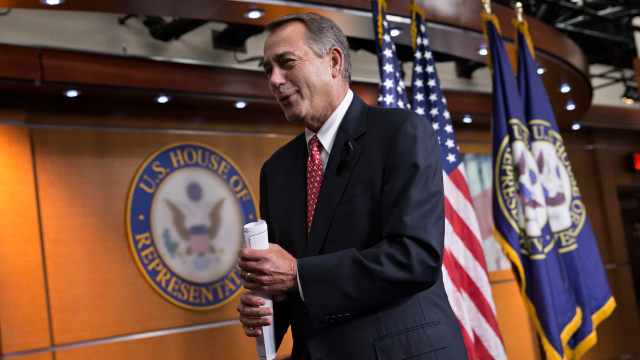
House Speaker John Boehner of Ohio leaves a news conference on Capitol Hill in Washington, Thursday, Dec. 12, 2013, where he vehemently rebuked conservative groups who oppose the pending bipartisan budget compromise struck by House Budget Committee Chairman Rep. Paul Ryan, R-Wis., and Senate Budget Committee Chair Sen. Patty Murray, D-Wash. (AP Photo/J. Scott Applewhite)
On Monday evening, in an attempt to avoid another government shutdown, House and Senate negotiators released a draft of a budget deal — the first detailed spending agreement since 2011.
But less than two weeks after outgoing Fed Chair Ben Bernanke said that “excessively tight” budgets were “counterproductive,” and had made the recovery “weaker than it otherwise would be,” the draft announced Monday maintains many of the cuts from the disastrous sequester deal.
The Guardian’s Dan Roberts reports that Republicans had backed off of their previous demand for deeper cuts to the food stamp program, settling instead for partially defunding Wall Street regulators.
Roberts writes:
Hal Rogers, the Republican chairman of the House appropriations committee, singled out the budget for the Securities and Exchange Commission in a press release, which received $324m less than it requested and $25m taken from reserves he called “a slush fund”.
Wall Street lobbyists have been pressing Congress to curb the growing power of regulators like the SEC in the wake of the financial crisis and Rogers said the spending bill had also [designated] $44m to an economic review of its rule-making process.
This decision, and similar cuts to the Commodity Futures Trading Commission, brought an angry response from Wall Street campaigners.
“It is shameful that Wall Street’s allies in Congress have again failed to fund the very agencies that are charged with protecting Main Street and preventing another financial crisis,” said Dennis Kelleher, president and CEO of Better Markets, an independent nonprofit organisation that promotes the public interest in the financial markets.
“The only reason not to fully fund the CFTC and the SEC is to protect Wall Street profits, bonuses and reckless trading. This rewards Wall Street’s lobbyists and campaign cash while endangering American families,” he added.
And while polls show that Americans think public spending has increased dramatically, Politico reports that non-military discretionary spending is still down significantly since Obama entered the White House:
What’s most telling is to compare the numbers now with spending levels six years ago for fiscal 2008 — the last full budget cycle under Obama’s predecessor, President George W. Bush.
Total discretionary spending for 2008 was $1.176 trillion, more than half of which, or $642.1 billion, was designated for the Pentagon and military operations — in Iraq then as well as Afghanistan.
That left $534.4 billion among the 11 other appropriations bills, almost exactly what will be the case now in the 2014 omnibus. The big difference is inflation. And when the Bush dollars are adjusted upward to reflect changes in the cost of living since 2008, it shows that Obama will be left with about 10 percent, or $53 billion, less than his predecessor.
But that comparison is incomplete; according to the Census Bureau, the US population has grown by over four percent over that same period.
Finally, Sam Stein reports for the Huffington Post that the scientific community “isn’t happy” about the deal, which restores a fraction of the sequester’s budget cuts for research. Stein writes:
…The NIH budget target falls short of what both the White House and Senate Democrats wanted. House Democrats said it was $714 million less than “the 2013 enacted level” of $30.648 billion. According to the NIH’s own numbers, meanwhile, it is approximately $950 million less than its 2012 level. In fact, the number is lower than during President Barack Obama’s first year in office and, when adjusted for inflation, is lower than it was in every year but the first of the George W. Bush administration.
“The FY14 omnibus spending bill falls short of restoring funding for lifesaving National Institutes of Health (NIH) biomedical research,” said Carrie Wolinetz, president of United for Medical Research, a coalition of leading research and medical institutions. “The proposed package won’t adequately reverse the damage done by last year’s budget sequester and ensure the nation’s biomedical research enterprise makes continued progress in lifesaving research and development.”
The sequester resulted from a 2011 standoff between the White House and House Republicans who were threatening to not raise the government’s debt limit. The Congressional Budget Office estimated that the cuts shaved 0.6 percent off of last year’s economic growth, and cost the economy 750,000 jobs.

